Click on images to enlarge
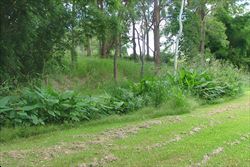
infestation along a drain (Photo: Sheldon Navie)
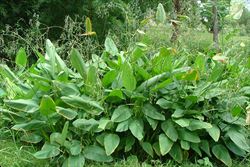
dense infestation (Photo: Sheldon Navie)

habit (Photo: Sheldon Navie)
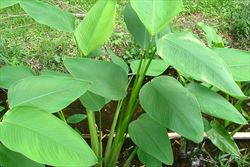
leaves (Photo: Sheldon Navie)
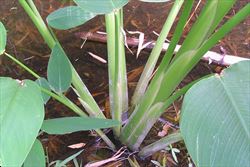
leaf stalks, emerging from the water, with sheathed bases (Photo: Sheldon Navie)

close-up of fleshy leaf stalks with sheathed bases (Photo: Sheldon Navie)

the large leaf blade (Photo: Sheldon Navie)
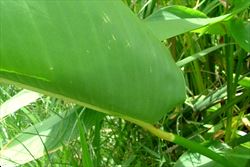
close-up of leaf underside with prominent midrib (Photo: Sheldon Navie)
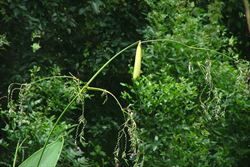
the very large, branched, drooping, flower cluster with leafy bracts (Photo: Sheldon Navie)
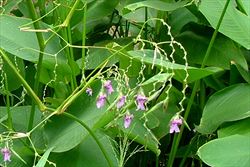
flowers at the tips of zig-zagging flowering branches (Photo: Sheldon Navie)

close-up of hairy branched flowering stem (Photo: Sheldon Navie)
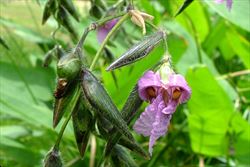
close-up of flowers, immature fruit, and pruplish-green hairy floral bracts (Photo: Sheldon Navie)

mature fruit (Photo: Sheldon Navie)

habit of powdery thalia (Thalia dealbata), with upright flower clusters (Photo: Sheldon Navie)

dense flower cluster of powdery thalia, Thalia dealbata (Photo: Sheldon Navie)
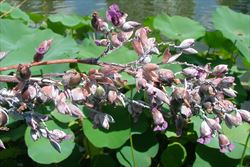
flowers and fruit of powdery thalia (Thalia dealbata), that are partially covered with a whitish powdery substance (Photo: Sheldon Navie)

red-stemmed thalia (Thalia geniculata 'Ruminoides'), being grown in a public wtaer feature (Photo: Sheldon Navie)
Scientific Name
Thalia geniculata L.
Family
Marantaceae
Common Names
alligator flag, alligator-flag, arrowroot, bent alligator-flag, bent alligatorflag, fire flag, fire-flag, giant water canna, greater thalia, hardy water canna, thalia, water canna
Origin
Native to south-eastern USA (i.e. Florida and Louisiana), Mexico, Central America (i.e. Belize, Costa Rica, El Salvador, Honduras, Nicaragua and Panama), the Caribbean, South America (i.e. French Guiana, Guyana, Surinam, Brazil, Bolivia, Colombia, Ecuador, Argentina and Paraguay) and tropical Africa (i.e. Chad, south-western Ethiopia, Sudan, Cameroon, Zaire, Benin, the Ivory Coast, Ghana, Guinea, Liberia, Nigeria, Senegal, Sierra Leone and Zambia).
Cultivation
Thalia (Thalia geniculata) is commonly grown in private and public gardens as an ornamental, particularly in ponds and water features. A form with red leaf stalks is also popular in cultivation. This plant is known as red-stemmed thalia (Thalia geniculata 'Ruminoides' or Thalia geniculata forma ruminoides).
Naturalised Distribution
Locally naturalised in south-eastern Queensland. This species was first recorded as naturalised in Toowong in Brisbane in January 2006. It has since been recorded from waterways in other parts of Brisbane including along Ithaca and Ekibin Creeks.
Habitat
This species prefers wet habitats such as ponds, roadside ditches, swamps, the margins of lakes and dams, and along waterways. In its native range in North America it grows in ponds, swamps, marshes, and along stream banks.
Habit
A large upright plant, growing up to 3 m or more in height. It spreads via short, thick underground stems (i.e. rhizomes) to form large clumps. The rhizomes are usually found in the mud under the water surface and give rise to clumps of upright leaves that have their bases under the water surface (i.e. usually growing as an emergent, with the base of the plant submerged and the majority of the plant growing above the water surface).
Distinguishing Features
- a large upright plant forming large clumps and growing up to 3 m or more in height.
- it usually grows in water and most of its leaves are tufted at the base of the plant.
- these leaves have a long and thick stalk and a very large leaf blade (up to 75 cm long and 25 cm wide).
- its purple flowers are borne in large branched clusters at the top of the flowering stems.
- these flowers are partially enclosed in green or purple-tinged hairy bracts (13-28 mm long).
- its small fruit (9-12 mm long) are shed from the plant along with the floral bracts.
Stems and Leaves
The leaves consist of a long and thick stalk (i.e. petiole) and a very large and expanded leaf blade. These leaf stalks have sheaths at their bases that enclose either the flowering stems or the bases of other leaf stalks. Leaf stalks of younger plants are generally thicker and more buoyant in nature than those on older plants. The very large leaf blades (up to 75 cm long and 25 cm wide) have a large midrib that is prominently raised on their undersides. These leaves also have entire margins and pointed tips (i.e. acute apices).
Flowers and Fruit
The flowers are borne in large branched clusters at the top of the plant (i.e. in terminal panicles). These clusters have a couple of large leafy bracts at the joints of the main branches. The flowers themselves are clustered near the ends of the drooping branch tips. These flowers have an unusual and complex structure. Pairs of stalkless (i.e. sessile) flowers are partially enclosed in green, or occasionally purple-tinged, hairy bracts (13-28 mm long). These flowers are exact mirror-images of each other and may be easily mistaken for a single flower. They are pale to dark purple in colour (about 20 mm long), with yellowish centres, and are made up of three partially fused petals and a couple of petal-like structures (i.e. staminodes). Flowering occurs mostly during summer and early autumn.
The small fruiting capsules (9-12 mm long and 6-7 mm wide) are almost round in shape (i.e. ellipsoid) and do not split open at maturity. Each of these fruit contains a single large smooth seed (7-10 mm long and 5-6 mm wide) that is dark brown to black in colour. The fruit are shed from the plant along with the floral bracts and the stem they leave behind usually has a conspicuous zig-zagging appearance.
Reproduction and Dispersal
Thalia reproduces by seed and also spreads laterally via its creeping underground stems (i.e. rhizomes).
The seeds can be dispersed downstream during floods, as can pieces of rhizome that are dislodged from larger plants. Both, but particularly the rhizomes, can also be spread into waterways in dumped garden waste.
Environmental Impact
Thalia (Thalia geniculata) is an emerging environmental weed in south-eastern Queensland. It is a potentially serious weed of waterways and other wetter habitats in the warmer coastal districts of Australia.
Legislation
Not declared or considered noxious by any state government authorities.
Similar Species
Another closely related introduced species, powdery thalia (Thalia dealbata), has also recently become naturalised in south-eastern Queensland. Unlike Thalia (Thalia geniculata), this species has tightly-bunched upright flower clusters. It can also be distinguished by its hairless floral bracts, which are often covered in a whitish powdery substance.

